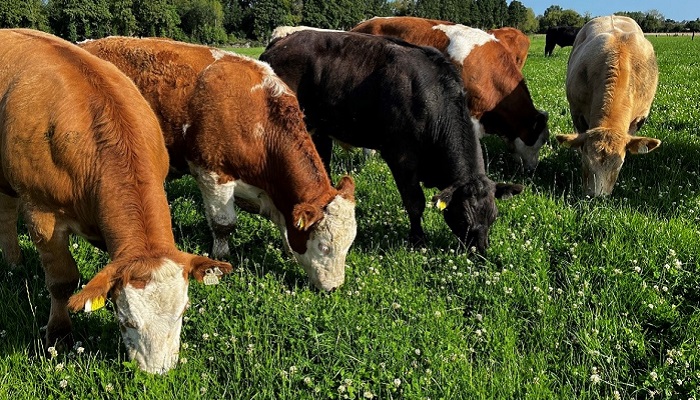05 March 2024
Does white clover increase beef animal live-weight gain?

Through the Derrypatrick herd, researchers in Teagasc Grange are examining how white clover inclusion in grassland swards effects animal performance, Peter Doyle, Research Officer, tells us more.
There is no doubt that white clover has a role a role to play in meeting our greenhouse gas (GHG) emissions targets by reducing our fertiliser nitrogen input. Extensive research from Teagasc also outlines that dairy cows grazing grass white clover swards achieve 8 % higher milk production per animal compared to cows grazing grass-only swards. However, there a paucity of information on live-weight gain (LWG) response of beef cattle grazing grass white clover swards.
Therefore, in spring 2023, suckler bred yearling steers and heifers in the Derrypatrick herd were assigned to a grass-only or grass-clover sward for the entire grazing season. The objective of the experiment was to quantify the carcass gain on grass white clover compared to grass-only swards over one grazing season. At the end of the grazing season, animals were slaughtered off grazed pasture.
Over one grazing season results indicate that animals grazing grass white clover swards had a 24 kg greater live-weight gain (+ 0.1 kg/day LWG) than those grazing grass-only swards. This equated to a 14 kg difference in carcass weight. Therefore, it is clear that beef farms that incorporates white clover into their pastures can reap the rewards of both a live-weight gain benefit and reduced nitrogen bill. This directly improves profitability and reduces the farm’s carbon footprint, providing a ‘win-win’ situation. There were also no incidences of bloat on the farm last year.
How to get white clover into pastures?
The successful establishment of white clover requires careful management. Incorporating white clover in a full reseed is the most reliable method of clover establishment. However, over sowing is a simple and low cost method of introducing white clover into swards. It is recommended that a combination of both methods (reseed and over sowing) are used throughout the farm over a multi-year period, where 10 % of the farm area is reseeded and 15 % of the area is over sown each year. There are numerous queries around how to over sow white clover. The success of over sowing is very much dependent on soil fertility, weather conditions at over sowing and grazing management after sowing. Over the past 2 years, the Derrypatrick herd has successfully over sown white clover into grass pastures, and plans to continue this into the future.

White clover establishing post over sowing
There are a number of key steps that must be carefully followed to successfully over sow white clover including:
- Correct soil fertility is essential, not optional (Soil index 3/4 for P and K and pH ≥ 6.3).
- Control weeds in the previous year.
- Open sward – soil is visible – which allows for good soil-to-seed contact and light penetration.
- Graze the sward out tight (4 cm) before over sowing.
- Timing – late March to April/May is desired as over sowing during the summer in dry conditions can prove to be difficult.
- Medium white clover leaf varieties are most suitable for cattle swards, sown at a rate of 2.5kg of seed per acre.
- There are a number of over sowing methods, and most are equally successful as long as the right conditions and post-management are correct.
- To ensure good seed-soil contact, applying watery slurry or rolling can help.
Post-sowing management
Correct post-sowing management is critical and revolves around the basic principles of having light available to the base of the sward for the young emerging clover plant. This encourages stolon development and prevents the existing grass plants smothering out the clover. Thus, the necessary steps include:
- The first grazing after over sowing should be at a pre-grazing herbage mass of 600-1,000kg DM/ha.
- The subsequent three grazings should be at a pre-grazing herbage mass of <1,100 kg DM and graze swards to ≤4 cm (graze tight). This will mean that the rotation lengths for these paddocks are very short (~2 weeks).
- No silage should be harvested from the sward in the first 12 months after sowing.
- Swards should be grazed later in the autumn to avoid carrying heavy covers over the winter.
A minority of paddocks in Derrypatrick had a poor response to over sowing. These tended to have a ‘thick base’ in the sward and, thus, it was difficult for light to penetrate to the base. These paddocks will be reseeded in the future. The Teagasc website contains the appropriate steps for reseeding. Spring reseeds (April/May) tend to provide better clover establishment than autumn reseeds (August).
Future research plans in the Derrypatrick herd
The study outlined above investigated the impact of grass-white clover swards on animal performance over one grazing season. The latest experiment in the Derrypatrick herd is investigating the impact of clover on the lifetime performance of beef cattle, i.e. from birth to slaughter within a suckler calf-to-beef system.
Diary Date
More research findings from the Derrypatrick herd will be presented at the Beef 2024 Open Day in the Teagasc, Animal & Grassland Research and Innovation Centre, Grange, Co. Meath, on June 26 2024.
